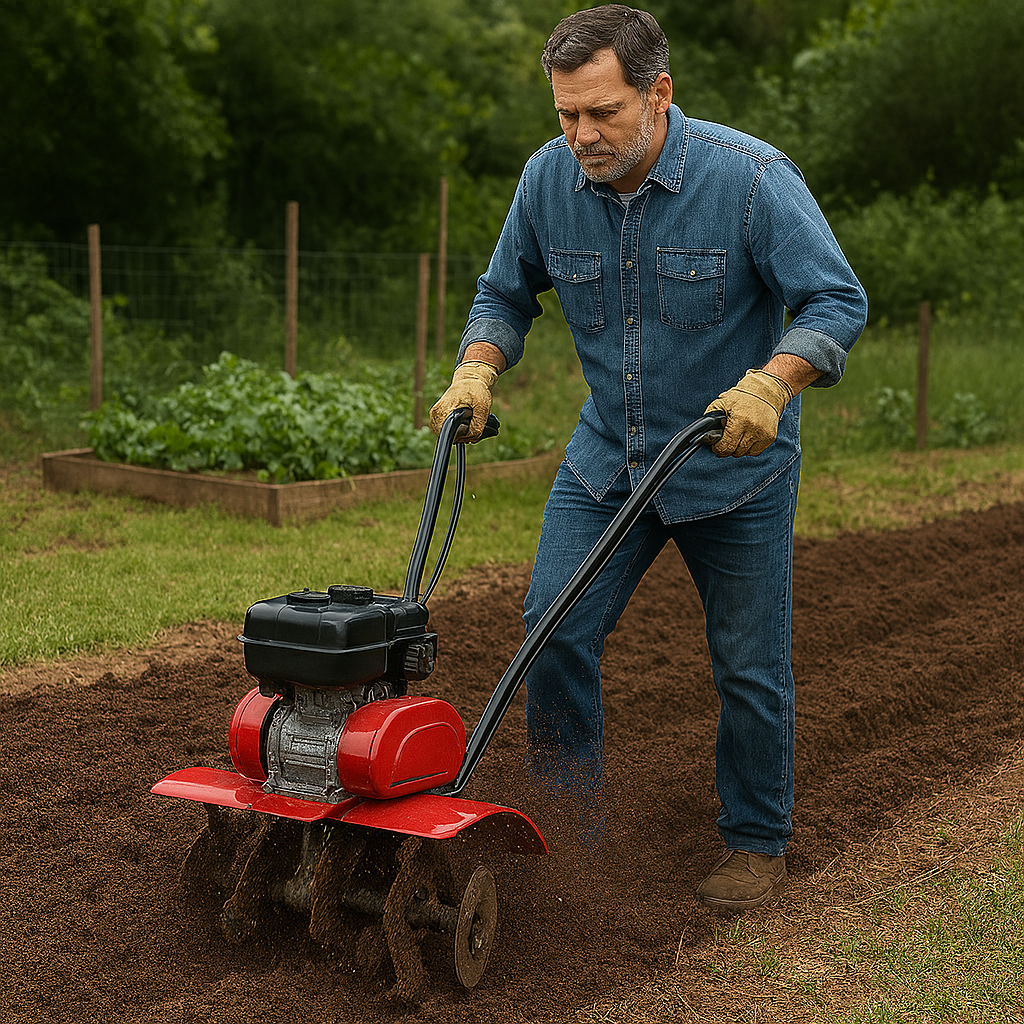
Using a rotary hoe to prepare garden beds
Why a Rotary Hoe Can Save You Hours in the Garden (and Help Your Veggies Thrive)
When the weather warms up and it’s time to get your veggie garden going, there’s one job that every gardener dreads—breaking up the soil. Whether your garden is a large plot or just a couple of raised beds, getting the ground ready can be one of the most time-consuming (and back-breaking) parts of growing your own food. I used to do that myself, working with a spade turning over the soil for days. It was definitely a game changer when we bought our first petrol rotary hoe
In this post, we’ll walk through:
- What a rotary hoe is and how it works
- Why it saves you time and energy
- How it helps create better growing conditions
- Why it’s not just for large gardens
- What to consider before you try one
Let’s dig into why this tool might just become your new favorite garden helper.
What Exactly Is a Rotary Hoe?
A rotary hoe—also known as a rotary tiller or cultivator—is a powered gardening tool with rotating blades or tines that dig into the soil. As it spins, it breaks up compacted dirt, mixes in compost or organic matter, and leaves behind loose, fluffy soil that’s perfect for planting.
It’s commonly used before seeding or transplanting veggies, helping prepare a smooth, even bed that supports strong root growth.
Rotary hoes can be powered by gas, electric cords, or even battery—ranging from large, professional machines to lightweight models that are perfect for home gardeners.
Why It’s So Much Faster Than Hand Digging
If you’ve ever spent a Saturday turning over a garden bed with a spade, you’ll know that it’s slow, sweaty work. Depending on your soil, weather, and strength, prepping just a few meters of garden can take hours.
A rotary hoe can cut that time drastically. In many cases, what might take two or three hours by hand can be done in 20–30 minutes with a rotary hoe.
It also saves energy. Instead of bending, lifting, and twisting with every shovelful of dirt, you just guide the tool across the surface—letting it do the hard work for you.
The Right Soil Makes All the Difference
One of the best things a rotary hoe does is create loose, aerated soil. That might not sound glamorous, but it makes a huge difference for plant health. Loose soil helps:
- Seeds germinate more easily
- Roots spread out and grow strong
- Water soak into the ground evenly
- Oxygen circulate through the soil
It’s also great for mixing in compost, worm castings, or any organic amendments your garden needs. That means better growing conditions from the very start, especially if you’re planting things like carrots, beets, or potatoes that need room to grow underground.
Think Your Garden Is Too Small? Think Again
You don’t need a big lifestyle block or a giant field to benefit from a rotary hoe. In fact, smaller electric or battery-powered models are designed specifically for urban gardens, raised beds, and smaller plots.
If you have:
- A backyard veggie patch
- Several raised garden beds
- A front-yard food garden
- A compact homestead setup
…there’s likely a rotary hoe that fits your space. Many smaller models are lightweight, easy to store, and simple to use—making them ideal for older gardeners, busy families, or those with limited mobility.
Even if you only use it a few times a year, it can be well worth the time and effort saved.
Before You Try One: A Few Tips
If you’re thinking about trying a rotary hoe (or renting one to start with), here are a few things to keep in mind:
- Soil moisture matters – Avoid tilling when the soil is soggy or bone dry.
- Clear large debris – Pick out rocks, sticks, and weeds before you begin.
- Start shallow – Go over your garden in passes, gradually going deeper.
- Safety first – Wear boots, gloves, and eye protection—those tines spin fast!
- Don’t overdo it – One or two passes are usually enough.
It’s also a good idea to consider whether you want to rent or buy. If you garden regularly or have more than one area to prep, owning your own can be much more convenient.
What’s Next?
In our next post, we’ll walk through some of the best rotary hoes available today—from budget-friendly electric models to powerful petrol options. Whether you’ve got a tiny courtyard or a whole veggie oasis, there’s something out there that can make garden prep a breeze.
We’ll also help you decide:
- What type of rotary hoe suits your garden size
- What features to look for
- And how to get the best value for your money
Ready to take the next step? Keep an eye out for our upcoming buying guide for rotary hoes—perfect if you’re ready to spend less time digging and more time growing.
